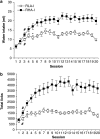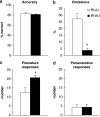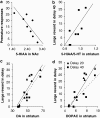Impulsivity characterization in the Roman high- and low-avoidance rat strains: behavioral and neurochemical differences
- PMID: 20090672
- PMCID: PMC3055403
- DOI: 10.1038/npp.2009.224
Impulsivity characterization in the Roman high- and low-avoidance rat strains: behavioral and neurochemical differences
Abstract
The selective breeding of Roman high- (RHA) and low-avoidance (RLA) rats for rapid vs extremely poor acquisition of active avoidance behavior in a shuttle-box has generated two phenotypes with different emotional and motivational profiles. The phenotypic traits of the Roman rat lines/strains (outbred or inbred, respectively) include differences in sensation/novelty seeking, anxiety/fearfulness, stress responsivity, and susceptibility to addictive substances. We designed this study to characterize differences between the inbred RHA-I and RLA-I strains in the impulsivity trait by evaluating different aspects of the multifaceted nature of impulsive behaviors using two different models of impulsivity, the delay-discounting task and five-choice serial reaction time (5-CSRT) task. Previously, rats were evaluated on a schedule-induced polydipsia (SIP) task that has been suggested as a model of obsessive-compulsive disorder. RHA-I rats showed an increased acquisition of the SIP task, higher choice impulsivity in the delay-discounting task, and poor inhibitory control as shown by increased premature responses in the 5-CSRT task. Therefore, RHA-I rats manifested an increased impulsivity phenotype compared with RLA-I rats. Moreover, these differences in impulsivity were associated with basal neurochemical differences in striatum and nucleus accumbens monoamines found between the two strains. These findings characterize the Roman rat strains as a valid model for studying the different aspects of impulsive behavior and for analyzing the mechanisms involved in individual predisposition to impulsivity and its related psychopathologies.
Figures







Similar articles
-
5-HT(2A) and mGlu2 receptor binding levels are related to differences in impulsive behavior in the Roman Low- (RLA) and High- (RHA) avoidance rat strains.Neuroscience. 2014 Mar 28;263:36-45. doi: 10.1016/j.neuroscience.2013.12.063. Epub 2014 Jan 8. Neuroscience. 2014. PMID: 24412375
-
The psychogenetically selected Roman high- and low-avoidance rat lines: a model to study the individual vulnerability to drug addiction.Neurosci Biobehav Rev. 2007;31(1):148-63. doi: 10.1016/j.neubiorev.2006.07.008. Neurosci Biobehav Rev. 2007. PMID: 17164110 Review.
-
A Genetic Model of Impulsivity, Vulnerability to Drug Abuse and Schizophrenia-Relevant Symptoms With Translational Potential: The Roman High- vs. Low-Avoidance Rats.Front Behav Neurosci. 2019 Jul 5;13:145. doi: 10.3389/fnbeh.2019.00145. eCollection 2019. Front Behav Neurosci. 2019. PMID: 31333426 Free PMC article.
-
The Roman high- and low-avoidance rats differ in the sensitivity to shock-induced suppression of drinking and to the anxiogenic effect of pentylenetetrazole.Pharmacol Biochem Behav. 2018 Apr;167:29-35. doi: 10.1016/j.pbb.2018.02.004. Epub 2018 Mar 2. Pharmacol Biochem Behav. 2018. PMID: 29477747
-
Contribution of the Roman rat lines/strains to personality neuroscience: neurobehavioral modeling of internalizing/externalizing psychopathologies.Personal Neurosci. 2023 Oct 4;6:e8. doi: 10.1017/pen.2023.7. eCollection 2023. Personal Neurosci. 2023. PMID: 38107777 Free PMC article. Review.
Cited by
-
Neonatal 6-OHDA lesion model in mouse induces Attention-Deficit/ Hyperactivity Disorder (ADHD)-like behaviour.Sci Rep. 2018 Oct 18;8(1):15349. doi: 10.1038/s41598-018-33778-0. Sci Rep. 2018. PMID: 30337626 Free PMC article.
-
A Pilot Randomized Controlled Trial to Explore Cognitive and Emotional Effects of Probiotics in Fibromyalgia.Sci Rep. 2018 Jul 19;8(1):10965. doi: 10.1038/s41598-018-29388-5. Sci Rep. 2018. PMID: 30026567 Free PMC article. Clinical Trial.
-
NMR-based Metabolomics and Fatty Acid Profiles to Unravel Biomarkers in Preclinical Animal Models of Compulsive Behavior.J Proteome Res. 2022 Mar 4;21(3):612-622. doi: 10.1021/acs.jproteome.1c00857. Epub 2022 Feb 10. J Proteome Res. 2022. PMID: 35142515 Free PMC article.
-
High impulsivity predicting vulnerability to cocaine addiction in rats: some relationship with novelty preference but not novelty reactivity, anxiety or stress.Psychopharmacology (Berl). 2011 Jun;215(4):721-31. doi: 10.1007/s00213-011-2167-x. Epub 2011 Jan 28. Psychopharmacology (Berl). 2011. PMID: 21274702
-
The relationship between adjunctive drinking, blood ethanol concentration and plasma corticosterone across fixed-time intervals of food delivery in two inbred mouse strains.Psychoneuroendocrinology. 2013 Nov;38(11):2598-610. doi: 10.1016/j.psyneuen.2013.06.011. Epub 2013 Jul 2. Psychoneuroendocrinology. 2013. PMID: 23827168 Free PMC article.
References
-
- Aguilar R, Gil L, Gray JA, Driscoll P, Flint J, Dawson GR, et al. Fearfulness and sex in F2 Roman rats: males display more fear though both sexes share the same fearfulness traits. Physiol Behav. 2003;78:723–732. - PubMed
-
- American Psychiatric Association 2000Diagnostic and Statistical Manual of Mental Disorders4th edn, text revision.American Psychiatric Press: Washington, DC
-
- Annetrude JG, de Mooij-van Malsen A, Berend Olivier AB, Martien JHK. Behavioural genetics in mood and anxiety: a next step in finding novel pharmacological targets. Eur J Pharmacol. 2008;585:436–440. - PubMed
-
- Aubry JM, Bartanusz V, Driscoll P, Schulz P, Steimer T, Kiss Jz. Corticotropin-releasing factor and vasopressin mRNA levels in Roman high- and low-avoidance rats: response to open-field exposure. Neuroendocrinology. 1995;61:89–97. - PubMed
Publication types
MeSH terms
Substances
LinkOut - more resources
Full Text Sources
Miscellaneous

